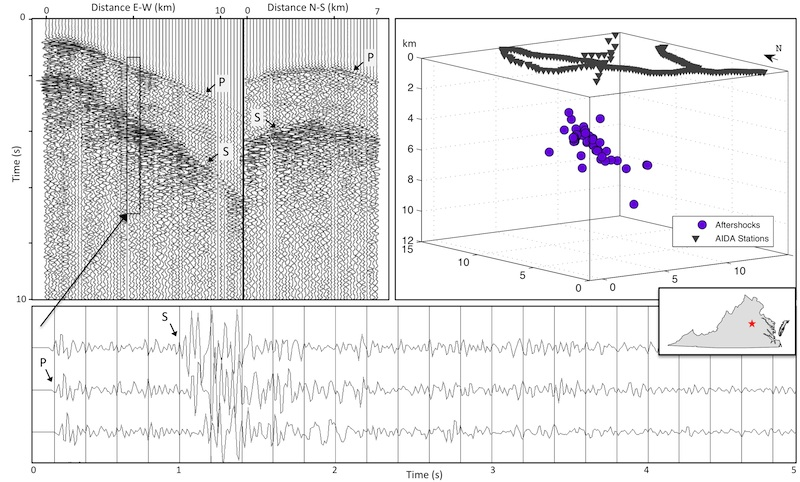2012 IRIS Workshop
Aftershock Imaging with Dense Arrays (AIDA) Following the August 23, 2011 Virginia Earthquake
K.K. Davenport: Virginia Tech, J.A. Hole: Virginia Tech, L.D. Brown: Cornell University, D.A. Quiros: Cornell University, L. Han: Virginia Tech, W. Mooney: U.S. Geological Survey Menlo Park, M. Chapman:
Magnitude 1.9 aftershock recorded on two perpendicular lines of vertical-component seismometers. The 200-m station spacing allows correlation of events and advanced waveform analysis methods. Three-dimensional projection of a small subset of the aftershocks, defining the fault plane.

Full-resolution graphics file in original format: 0064.jpg
The August 23, 2011, magnitude 5.8 earthquake in Louisa Co., Virginia, provided an opportunity to test a novel type of high-density aftershock deployment utilizing EarthScope Flexible Array instruments. Beginning August 27, AIDA deployed 201 stations in three phases, including lines with a 200-m station spacing above the aftershock zone and a 60-km long regional profile. The survey was designed to record wavefields at sufficiently dense spacing to minimize spatial aliasing and lower the event detection threshold. This use of array methods will allow the location the aftershocks with high precision and the imaging of geologic structure with resolution on par with typical controlled-source crustal surveys. Preliminary work has focused on joint tomography for seismic velocity and hypocenter locations, vertical seismic profile event stacking, and ambient noise imaging. Preliminary aftershock locations define a best-fitting plane striking ~25° and dipping 55° E, consistent with the moment tensor solution for the main shock. Ongoing work includes locating more of the >1000 events with high signal-to-noise, event imaging using reverse-time waveform migration, and applying interferometry methods to image earth structure. The resulting high-resolution subsurface images and aftershock characterization will help constrain the geologic model of the region, and provide a template for future high-density aftershock deployments.
Acknoweldgements: NSF EAR-1160666 to Virginia Tech; NSF EAR-1160663 to Cornell University; technical support from IRIS-PASSCAL using EarthScope USArray Flexible Array instruments
Keywords: aftershock, dense_array, virginia
